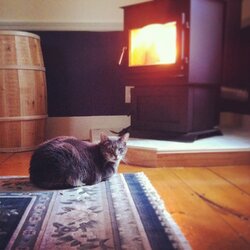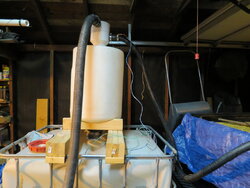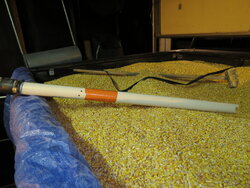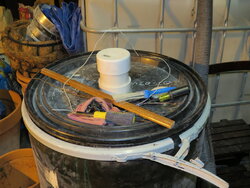Hi all, I've been lurking for a bit looking for some ideas on how to make my pellet transfer duties a bit easier this winter and I thought I'd see if anyone has better insight into my situation. I have a P43 (love it) on the main floor of my house, and we store our bagged pellets in the basement.They're delivered on pallets and we toss them down a ramp placed in our bulkhead, so transporting them for storage is covered.
My chagrin begins with hauling bags upstairs a couple times a week to keep a semi-decorative 5-bag capacity barrel next to the stove filled with loose pellets, from which we subsequently fill our stove by hand. I'd like to implement some sort of short-range vertical vacuum or auger system through a small hole in the floor to transport loose pellets up about ten feet into the holding barrel, or better yet, right into my stove hopper. My two possible approaches are as follows, and I'd like to hear any feedback (even, "you're an idiot; you'll blow up your house") if you have it:
1. Take the head off a powerful wet/dry vac and place it on the barrel (creating the needed vacuum), with the barrel acting as the holding container. Cut a 3" hole in the floor, stick the hose through it, and suck up pellets from a large trashbin in the basement that I can fill down there, without hauling the bags upstairs. I prefer this approach.
2. Create an auger out of a 6"x10ft PVC pipe and auger bit (http://www.harborfreight.com/6-inch-diameter-auger-bit-95973.html) with an extension pole. This would also go through the floor and into a trashbin filled with pellets. I'm not clear on the physics involved with a vertical auger, especially one that doesn't "auger" the whole way up the system. Will it "push" the pellets above the screw with pellets it draws up? Or just stop and bind up?
Any other ideas are welcome. We don't have central vac, and I'm looking to keep the project relatively inexpensive (hundreds at most, not thousands).
TL;DR: suck or screw? you decide ;-)
My chagrin begins with hauling bags upstairs a couple times a week to keep a semi-decorative 5-bag capacity barrel next to the stove filled with loose pellets, from which we subsequently fill our stove by hand. I'd like to implement some sort of short-range vertical vacuum or auger system through a small hole in the floor to transport loose pellets up about ten feet into the holding barrel, or better yet, right into my stove hopper. My two possible approaches are as follows, and I'd like to hear any feedback (even, "you're an idiot; you'll blow up your house") if you have it:
1. Take the head off a powerful wet/dry vac and place it on the barrel (creating the needed vacuum), with the barrel acting as the holding container. Cut a 3" hole in the floor, stick the hose through it, and suck up pellets from a large trashbin in the basement that I can fill down there, without hauling the bags upstairs. I prefer this approach.
2. Create an auger out of a 6"x10ft PVC pipe and auger bit (http://www.harborfreight.com/6-inch-diameter-auger-bit-95973.html) with an extension pole. This would also go through the floor and into a trashbin filled with pellets. I'm not clear on the physics involved with a vertical auger, especially one that doesn't "auger" the whole way up the system. Will it "push" the pellets above the screw with pellets it draws up? Or just stop and bind up?
Any other ideas are welcome. We don't have central vac, and I'm looking to keep the project relatively inexpensive (hundreds at most, not thousands).
TL;DR: suck or screw? you decide ;-)






